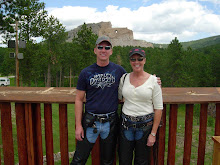The entire end of the LBH battle which ranged between Last Stand Hill and Deep Ravine is a confusing affair. Various theories exist about what happened when, etc. Indian accounts vary, and sometimes create even more confusion with timing and sequence. In very broad strokes, Custer and the regimental command element, plus C, E, and F troops were isolated on Last Stand Hill once Keogh's and Calhoun's commands were eliminated. Survivors of Keogh's and Calhoun's commands tried to make it to the hill; various scattered markers show how unsuccessful they were. Its truly sobering to stand on today's quiet Greasy Grass Hill and realize the terror and panic in the minds of those survivors as the warriors closed in.....its a chilling battlefield.
At some point, a substantial (40ish men) made for Deep Ravine. Was this an ordered attack by Custer to see if he could still break through to the village? Possibly hoping to link up with Reno, who "should" have been across the river pressuring the village? Was Custer dead at this point? Was the exodus to Deep Ravine a last desparate attempt to escape the slaughter? Common sense tells me that doesn't make sense....after all....why would you "escape" towards the village and the heaviest mass of warriors?
Anyway, some photos:
A view from Last Stand Hill down towards Deep Ravine (left in photo, toward trees). You can see the string of markers down the trail toward the ravine. The distances involved are truly staggering. 2000 warriors sounds like a LOT....until you begin to think of the enormous distances involved on the battlefield. But - if I was a trooper on Last Stand Hill....I would NOT go toward Deep Ravine unless ordered! I have a hard time believing it was an escape attempt, or a rout away from Last Stand Hill. That just doesn't smell right. Could the markers show deployments of a controlled skirmish line here and there? Maybe the markers show where troopers fell on their way BACK UP to Last Stand Hill after being ordered down toward the ravine to see if a crossing to the village was possible? Who knows....that's why this battle is so fascinating.
Looking toward Last Stand Hill, from the Deep Ravine trail. Many, many folds in the ground to shield warriors that closed out the battle laying down every conceivable type of fire on the area (arrows, repeating rifle fire, single shot muskets....).
Runs-Her-Man on the Deep Ravine trail, looking toward Last Stand Hill.
No Talk adopting a tourist pose further down on Deep Ravine Trail, with Last Stand Hill in the background.
Looking up the trail created down to Deep Ravine. Various markers dot the landscape as you look up to Last Stand Hill. Consider the isolation and sense of helplessness that troopers might have had if they found themselves in this position on that hot June afternoon.
Even farther down the trail. Note how far away Last Stand Hill is. It might as well have been on the moon.
Next time I'll add some photos of Last Stand Hill. I'll finish off with a couple of posts about Weir Point, and the Reno/Benteen battle area.
Subscribe to:
Post Comments (Atom)







Awesome stuff Brent. I want to go there some time for sure!
ReplyDeleteDeep Ravine is a mystery - the accounts of 28 bodies does not always jive with some Native American reports, and even the reports of folks from the various burial details.
ReplyDeleteI must say...if I found a magic lamp on the shore, rubbed it, and a genie popped out offering me three wishes...then...one of those wishes would be to know what really happened on June 25, 1876 on those sun-washed hills in Montana.